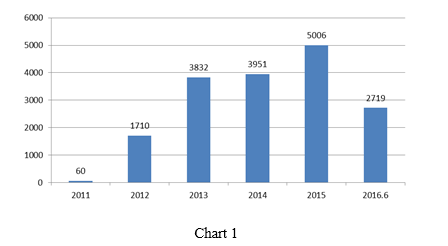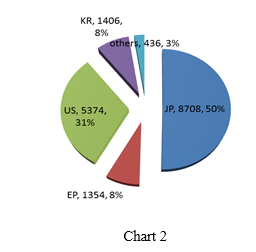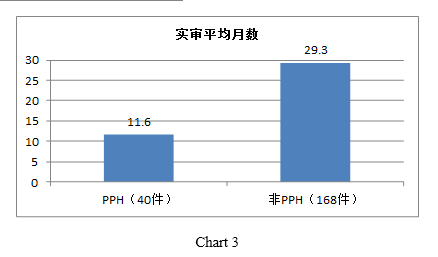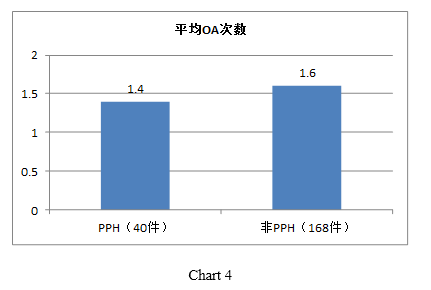Ms. Hongjie YUE
Chinese Patent Attorney
Mechanical Engineering Department
Linda Liu & Partners
PPH (Patent Prosecution Highway) has attracted more and more attention from applicants, especially the foreign applicants, as an important way for them to request acceleration of substantive examination for invention patent applications since the pilot run of China-Japan PPH program by SIPO on November 11, 2011. What petitioners are most concerned with is what kind of benefits PPH could bring to them. Therefore, this article will make an introduction to the benefits of PPH from three different aspects, namely the examination speed, the number of OA issuance and the granting rate.
First of all, let’s take a look at the condition of the PPH requests accepted by SIPO (all the data below comes from the global PPH website
http://www.jpo.go.jp/ppph-portal/statistics.htm which is maintained by JPO, unless otherwise stated).
Chart 1 shows the number of PPH requests accepted by SIPO from the year of 2011 to the end of June, 2016.

From Chart 1, it can be seen that SIPO accepted totally 17,278 PPH requests as of the end of June, 2016, showing an increase year by year.
Chart 2 is a pie chart showing the percentages of the Offices of First Filing regarding the above 17,278 PPH requests received by SIPO.

It can be concluded from Chart 2 that the PPH requests based on the examination results made by JPO, USPTO, EPO, KIPO dominate the PPH requests accepted by SIPO, especially the number of the PPH requests based on JPO being up to 8,708, accounting for 50% of the total PPH requests. In addition, based on our firm’s experience of handling PPH requests, PPH requests based on the examination results of JPO are mainly made by Japanese applicants, unlike the PPH requests based on the examination results of USPTO which might be filed by Japanese applicants or the applicants from other countries. So, it is possible that the real number of PPH requests filed by Japanese applicants is even higher than 50% of the total number.
Now we come to the key point of this article, which is, what kind of effects does PPH have in China?
When discussing the effects of PPH, we definitely need to take a look at the original purpose of establishing the PPH program, which is: acceleration.
How fast is the Highway exactly? The average data (from January 2016 to June 2016) for SIPO from global PPH website indicates that the average pendency from PPH request to First Office Action is 2.7 months, and the average pendency from PPH request to Final Decision (granting, rejection or the application is deemed to have been withdrawn) is 11.9 months.
The average 11.9 months mentioned above is calculated on the basis of the date of filing of PPH request, about which SIPO has the following strict provisions: 1) the application must have been published by SIPO in China, 2) the application must have entered into substantive examination stage (The applicant must have received the Notification of Invention Patent Application Entering into Substantive Examination Stage issued from the SIPO before, or when, filing the PPH request. Note that as the only permitted exception, the applicant may file a PPH request simultaneously with the request for substantive examination), 3) the application has not received any office action issued from the substantive examination department in SIPO. Although it can be seen from the said provisions that the time for filing the PPH request is not the same as that for entering substantive examination stage, most applicants will choose to file the PPH request after entering substantive examination stage as soon as possible, or even if an applicant chooses to file the PPH request while filing the request for substantive examination, SIPO will issue the Notification of Entering into Substantive Examination Stage within a month; therefore, it is reasonable to compare the above average pendency of 11.9 months for PPH requests calculated based on the filing date of the PPH requests with that of non-PPH applications calculated from the date of entering substantive examination stage (which is from the issuance of the Notification of Entering into Substantive Examination Stage to the conclusion of the case). So far, SIPO hasn’t released the average examination pendency of 2016, so we herein take the average examination pendency of 21.9 months for the invention patent applications in SIPO’s Annual Report of 2015 as the object to be compared. The above comparison indicates that the average pendency for PPH applications is shortened by 10 months than that for non-PPH applications, nearly half the pendency for non-PPH applications (10/21.9=45.7%), which proves that PPH can significantly accelerate the examination.
To further explore the difference in the examination speed between PPH applications and non-PPH applications, the writer analyzed the PPH and non-PPH applications our firm handled. The writer chose the granted PPH and non-PPH applications filed by the same applicant in the same period (from July 1, 2015 to June 30, 2016) as the objects to be compared to eliminate the influence exerted by different applicants and different examination standards held by SIPO in different periods to the comparison results so as to make the data more effective. Chart 3 shows the comparison of the examination pendency of PPH applications and that of non-PPH applications.

As seen from Chart 3, the average examination pendency for the 40 granted PPH applications of the applicant is only 11.6 months from July 1, 2015 to June 30, 2016 while for the non-PPH applications granted in the same period it is 29.3 months, with a huge difference of 17.7 months. The comparison in Chart 3 proves that PPH significantly accelerates the substantive examination of the invention patent applications for the applicant.
Among the 40 PPH applications, the shortest examination pendency is only 173 days (5.8 months) while the longest is 820 days (27.3 months). It can be concluded that there is a notable difference in the examination pendency between the respective PPH applications, which also verifies the information the writer learnt from examiners that SIPO does not make specific regulations about the examination pendency of PPH applications but only requests the examiner to give priority to PPH applications.
In addition, although the examination pendency of each application varies greatly, the above data shows that the longest examination pendency of 27.3 months for a PPH application is still 2 months shorter than the average pendency of 29.3 months for non-PPH applications. So, filing PPH requests has obvious effects in speeding up the examination.
Apart from the examination speed, the PPH applicants are also concerned with the cost. In the following part, the writer would explain whether PPH applications could reduce the cost by analyzing the number of Office Actions.
According to the global PPH website, the average number of Office Actions issued by SIPO (from January 2016 to June 2016) is about one time. Since SIPO has never given the number of Office Actions of non-PPH applications or all the applications, we cannot make a comparison. Based on the experience of the writer, the average one time of Office Action should be less than the average number of Office Actions issued for non-PPH applications; however, the number of about one time is too general to reflect the actual situation.
To more accurately explore whether there is any difference in the number of Office Actions between PPH applications and non-PPH applications, the writer analyzed the number of Office Actions of PPH applications and non-PPH applications of the above-mentioned applicant. Chart 4 below shows a comparison of the number of Office Actions between PPH applications and non-PPH applications.

Seen from the average number of Office Actions showed in Chart 4, the number of Office Actions of PPH applications is reduced by 0.2 times/application compared with non-PPH application. So filing PPH requests can reduce the cost to some extent by reducing the number of Office Actions.
With respect to whether PPH could exert positive effects on the granting rate, SIPO has never released any official data. And according to the PPH applications our firm has handled (only the data in the first and the second year since the pilot run of PPH program was analyzed, considering the present conclusion condition of the PPH applications), PPH does not have a significant effect in improving the granting rate.
In the first year since the pilot run of PPH program (from November 1, 2011 to October 31, 2012), the granting rate (obtained by dividing the number of the granted applications by the sum of the number of the granted applications and the number of the rejected applications) of the nearly 50 PPH applications handled by our firm is 7% higher than that of the more than 500 applications entering the substantive examination stage in the same period. In the second year of coping with the PPH requests (from November 1, 2012 to October 31, 2013), the granting rate of the more than 100 PPH applications handled by our firm is 1% higher than that of the more than 1000 applications entering the substantive examination stage in the same period. These data shows that the granting rate of PPH applications is only slightly higher than that of non-PPH applications.
It can be concluded from the above analysis that the main effect of PPH is to accelerate the examination. The writer has two suggestions below on how to utilize PPH more effectively.
Firstly, bring the application into the substantive examination stage as soon as possible. The applicant can file a request for substantive examination when filing a new application with SIPO. As mentioned above, SIPO provides that the applicant can file a PPH request only after SIPO publishes the invention patent application and issues the Notification of Invention Patent Application Entering into Substantive Examination Stage. Note that as the only exception, the applicant may file a PPH request while filing the request for substantive examination after publication of the invention patent application. The writer learnt from examiners that regarding the PPH examination procedure, even if under the exceptional condition above mentioned, examiners working on PPH requests would still wait SIPO to issue the Notification of Invention Patent Application Entering into Substantive Examination Stage and then determine whether to accept the PPH request. Therefore, bring the application into the substantive examination stage as soon as possible accelerates the examination.
Secondly, reply Office Actions as soon as possible. Regarding the deadline for replying Office Actions issued to PPH applications, SIPO does not make any special provision. The time limit for replying the first Office Action is still 4 months, and for the N-times Office Actions (N is equal to or greater than 2), the time limit for making a response is still 2 months and the applicants are allowed to apply for the grace period. Therefore, it is advisable to reply Office Action as soon as possible if the applicant has an urgent need for accelerating the examination.
Last but not least, the writer needs to remind the applicants who are interested in PPH that the examiners examining whether the PPH requests could be accepted in SIPO are examiners working on preliminary examination who are so strict with the examination of the form of the PPH request documents that any small defects (for example, filling a wrong name of a reference document) or any descriptions regarded as vague by examiners (for example, the description about the relationship between the present application in the Form of Request for Participation in the PPH Pilot Program and the OEE application, or the explanatory description of the correspondence between the claims of the present application and the claims of the corresponding OEE application) might result in a rejection directly. In addition, based on the experience of the writer, the examiners examining the PPH requests do not make a thorough examination of the PPH request document, so the following situation might arise: the second submitted PPH request document overcomes the defect which leads to the rejection of the first submitted PPH request, but the examiner rejects the second PPH request for other defects. SIPO only gives two opportunities for one invention patent application to file a PPH request. Hence, if the above mentioned situation arises, the applicant might be unable to file a PPH request again, which will result in a failure of acceleration. Taking all the possible situations into consideration, we suggest that the petitioners should choose and entrust an experienced and reliable IP law firm with the filing of the petitioners’ PPH requests.




